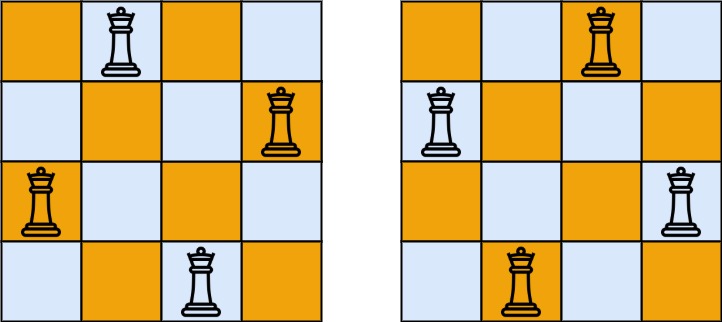
g0001_0100.s0051_n_queens.readme.md Maven / Gradle / Ivy
Go to download
Show more of this group Show more artifacts with this name
Show all versions of leetcode-in-java Show documentation
Show all versions of leetcode-in-java Show documentation
Java-based LeetCode algorithm problem solutions, regularly updated
The newest version!
51\. N-Queens
Hard
The **n-queens** puzzle is the problem of placing `n` queens on an `n x n` chessboard such that no two queens attack each other.
Given an integer `n`, return _all distinct solutions to the **n-queens puzzle**_. You may return the answer in **any order**.
Each solution contains a distinct board configuration of the n-queens' placement, where `'Q'` and `'.'` both indicate a queen and an empty space, respectively.
**Example 1:**

**Input:** n = 4
**Output:** [[".Q..","...Q","Q...","..Q."],["..Q.","Q...","...Q",".Q.."]]
**Explanation:** There exist two distinct solutions to the 4-queens puzzle as shown above
**Example 2:**
**Input:** n = 1
**Output:** [["Q"]]
**Constraints:**
* `1 <= n <= 9`
To solve the "N-Queens" problem in Java with the Solution class, follow these steps:
1. Define a method `solveNQueens` in the `Solution` class that takes an integer `n` as input and returns a list of lists of strings.
2. Initialize a board represented as a 2D character array of size `n x n`. Initialize all cells to `'.'`, indicating an empty space.
3. Define a recursive backtracking function `backtrack` to explore all possible configurations of queens on the board.
4. In the `backtrack` function:
- Base case: If the current row index `row` is equal to `n`, it means we have successfully placed `n` queens on the board. Add the current board configuration to the result.
- Iterate through each column index `col` from `0` to `n - 1`:
- Check if it's safe to place a queen at position `(row, col)` by calling a helper function `isSafe`.
- If it's safe, place a queen at position `(row, col)` on the board, mark it as `'Q'`.
- Recur to the next row by calling `backtrack(row + 1)`.
- Backtrack: After exploring all possibilities, remove the queen from position `(row, col)` by marking it as `'.'`.
5. In the `solveNQueens` method, initialize an empty list `result` to store the solutions.
6. Call the `backtrack` function with initial parameters `0` for the row index.
7. Return the `result` list containing all distinct solutions.
Here's the implementation of the `solveNQueens` method in Java:
```java
import java.util.*;
class Solution {
public List> solveNQueens(int n) {
List> result = new ArrayList<>();
char[][] board = new char[n][n];
for (int i = 0; i < n; i++) {
Arrays.fill(board[i], '.');
}
backtrack(board, 0, result);
return result;
}
private void backtrack(char[][] board, int row, List> result) {
int n = board.length;
if (row == n) {
result.add(constructBoard(board));
return;
}
for (int col = 0; col < n; col++) {
if (isSafe(board, row, col)) {
board[row][col] = 'Q';
backtrack(board, row + 1, result);
board[row][col] = '.';
}
}
}
private boolean isSafe(char[][] board, int row, int col) {
int n = board.length;
for (int i = 0; i < row; i++) {
if (board[i][col] == 'Q') {
return false;
}
}
for (int i = row - 1, j = col - 1; i >= 0 && j >= 0; i--, j--) {
if (board[i][j] == 'Q') {
return false;
}
}
for (int i = row - 1, j = col + 1; i >= 0 && j < n; i--, j++) {
if (board[i][j] == 'Q') {
return false;
}
}
return true;
}
private List constructBoard(char[][] board) {
List solution = new ArrayList<>();
for (char[] row : board) {
solution.add(new String(row));
}
return solution;
}
}
```
This implementation efficiently finds all distinct solutions to the N-Queens problem using backtracking. © 2015 - 2024 Weber Informatics LLC | Privacy Policy